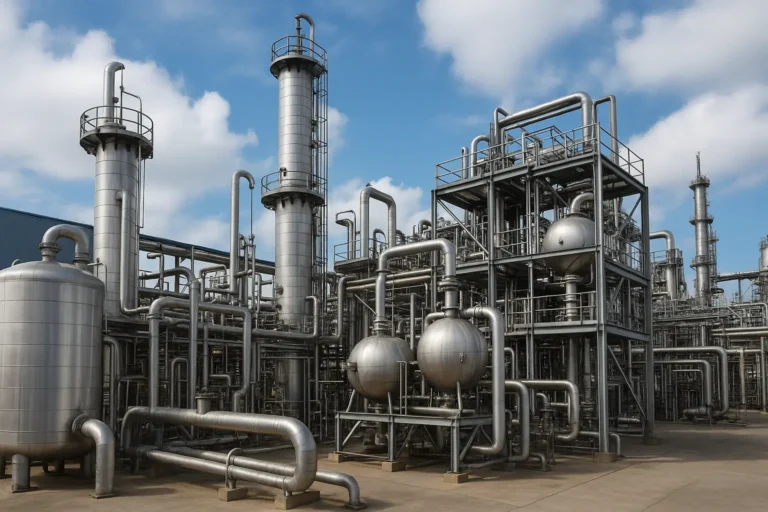Chemical Plant Installation
Chemical plant installation is a complex and critical process that involves multidisciplinary engineering efforts, strategic planning, and strict adherence to...
Devamını Oku

Transformer maintenance refers to the systematic inspection, testing, cleaning, and repair of transformers to ensure their optimal performance and prevent unexpected failures. These procedures are critical for facilities that rely on uninterrupted electrical power, such as factories, substations, and industrial plants. Regular and preventive transformer maintenance helps reduce the risk of breakdowns, extend equipment life, and improve safety. Without proper attention, transformers may suffer from insulation failures, overheating, or even total system shutdowns.
Transformer maintenance typically involves periodic checks and technical evaluations depending on the operating environment and load conditions. The transformer maintenance period can vary but is often recommended at least once per year. Environmental factors such as humidity, temperature, dust exposure, and electrical load levels can shorten this interval. Each maintenance cycle includes several steps like visual inspections, oil tests, insulation checks, grounding verification, and component replacements if needed.
Understanding how to do transformer maintenance requires professional knowledge and the use of proper equipment. The maintenance process ensures the system runs efficiently and meets legal safety requirements. In many regions, transformer maintenance is mandatory under electrical safety regulations. Especially in high-demand industries, neglecting these procedures may lead to legal penalties, production losses, or hazardous incidents.
A proper transformer installation should always be followed by a long-term maintenance plan. Maintaining detailed records of every service helps track performance trends and identify recurring issues. Knowing how many years transformer maintenance should be scheduled is essential to balancing cost and operational efficiency. When issues are found, professional transformer maintenance repair services step in to restore the system to optimal condition. For businesses, knowing how to do transformer maintenance repair ensures they can respond quickly and effectively to avoid prolonged downtime.
In any electrical system, transformers are critical components responsible for regulating voltage and ensuring the smooth transmission of power. Over time, various internal and external factors such as temperature fluctuations, environmental pollutants, and mechanical stress can degrade a transformer’s performance. Without regular transformer maintenance, these issues can go unnoticed until they cause significant system failures or safety hazards. Preventive maintenance ensures that these vital units operate efficiently and safely, reducing the risk of unplanned outages or dangerous malfunctions.
From an operational standpoint, transformer maintenance minimizes energy loss, optimizes performance, and extends the equipment’s lifespan. It also provides a strategic advantage by lowering long-term repair costs and enhancing workplace safety. Moreover, industries that rely on continuous power flow—such as manufacturing, oil & gas, and data centers—cannot afford the downtime caused by transformer failures. By proactively addressing minor issues during scheduled inspections, companies prevent catastrophic breakdowns. In essence, transformer maintenance is not just a technical necessity—it’s a business-critical investment in reliability and risk reduction.
The answer to the question “is transformer maintenance mandatory” is a resounding yes—especially in sectors where operational safety and energy reliability are legally regulated. Many national and international electrical codes require periodic transformer inspections to ensure compliance with safety standards. This includes checking insulation integrity, verifying grounding systems, and testing protective components like fuses and relays. Failure to comply with these regulations can lead to severe penalties, operational shutdowns, or even legal consequences in the event of an accident. Regular maintenance is also essential for meeting insurance and audit requirements in most industrial settings.
Aside from legal obligations, there are practical reasons why transformer maintenance must be treated as a non-negotiable routine. Transformers that go unchecked are prone to overheating, oil degradation, and component wear—issues that could escalate into complete system failure. In critical environments like hospitals, airports, and factories, an unexpected outage caused by a transformer fault can be catastrophic. Therefore, implementing a structured maintenance plan is not only about compliance; it’s about securing continuous operations and avoiding costly interruptions. Companies that ask “is transformer maintenance mandatory” must consider both regulatory risks and business impact.
The recommended transformer maintenance period varies depending on the type of transformer, its operational environment, and load conditions. In most cases, routine maintenance should be conducted annually. However, transformers in harsh environments—such as those exposed to high humidity, dust, or temperature fluctuations—may require biannual or even quarterly inspections. A well-planned maintenance schedule prevents small issues from evolving into major failures. By establishing and adhering to a consistent timeline, organizations ensure reliability, reduce repair costs, and maintain compliance with safety regulations.
Many engineers and facility managers ask, “how many years is transformer maintenance** required over the equipment’s lifetime?”** While there is no universal answer, most industrial transformers require servicing at least once a year, throughout their operational lifespan. Some components may have specific lifecycles that demand earlier attention. Long-term planning should include predictive analysis, maintenance logs, and trend tracking to optimize the schedule. Skipping scheduled maintenance can drastically shorten transformer life and jeopardize workplace safety. Ultimately, a strategic transformer maintenance period protects not only the equipment but also the continuity of operations.
Performing transformer maintenance involves a series of systematic procedures designed to ensure operational safety and efficiency. The process starts with a thorough visual inspection of external components, looking for signs of corrosion, oil leaks, or physical damage. This is followed by testing transformer oil for dielectric strength, moisture content, and acidity—all indicators of insulation health. Electrical measurements like insulation resistance and winding resistance are also conducted to detect abnormalities. Verifying the condition of bushings, checking grounding continuity, and testing protection systems such as relays and fuses are essential steps in the routine.
Professionals trained in how to do transformer maintenance use specialized tools to assess internal and external transformer performance. If deficiencies are found, technicians move to the transformer maintenance repair phase, which may involve tightening loose connections, replacing worn gaskets, flushing and refilling oil, or updating control systems. Each action is documented for future reference and regulatory compliance. All these procedures are typically carried out during planned shutdowns to minimize business disruption. Routine maintenance ensures that minor issues are resolved before they escalate into costly breakdowns, maximizing the transformer’s lifespan and performance.
The first step in transformer maintenance is conducting detailed visual and physical inspections. Technicians examine the outer casing for cracks, oil leaks, rust, or damage. They also inspect bushings, gaskets, cooling fins, and cable connections for wear or looseness. Any unusual noise, smell, or discoloration may indicate deeper issues. These checks help identify early warning signs that could compromise transformer performance or safety if left unaddressed.
Oil quality is a critical factor in a transformer’s insulation and cooling system. During the transformer maintenance period, technicians perform oil tests to measure dielectric strength, moisture levels, acidity, and the presence of dissolved gases. These indicators help evaluate the health of internal insulation. In addition, insulation resistance testing is conducted to detect potential breakdown points within the windings. Any abnormal values can prompt further investigation or repairs to prevent failures.
A thorough check of grounding systems, fuses, and protection relays is essential during transformer maintenance repair. Grounding connections must be tested for continuity and resistance to ensure fault currents are safely discharged. Fuses are inspected for integrity and proper ratings, while protection devices like relays are tested for accurate response times. Faulty components are replaced immediately to prevent electrical hazards or unplanned shutdowns.
An important part of understanding how to do transformer maintenance is recognizing the role of routine cleaning and component renewal. Dust, oil residue, and moisture are removed from external surfaces to prevent tracking and overheating. Loose electrical connections are tightened during compacting procedures, and worn or degraded parts—such as gaskets or insulators—are replaced. These preventive steps significantly enhance reliability and operational safety.
Transformer maintenance and repair processes involve a structured workflow that begins with diagnostics and ends with validation testing. The initial step includes reviewing historical data, performing inspections, and running essential tests such as oil analysis, thermal imaging, and insulation resistance checks. When irregularities are detected, the maintenance team prepares a customized action plan. This plan includes repair strategies, timelines, and safety precautions to minimize disruption during downtime. Components like gaskets, bushings, relays, and fuses are either repaired or replaced based on their condition.
For teams that need to understand how to do transformer maintenance repair, the process goes beyond fixing faults—it’s about ensuring long-term reliability. Repairs are typically executed during planned outages, followed by re-commissioning tests to confirm the system’s operational integrity. Documentation is essential throughout the process, from initial findings to final test results. This structured approach ensures regulatory compliance, workplace safety, and system optimization. Partnering with experienced maintenance providers guarantees that every repair meets industry standards. Ultimately, transformer maintenance and repair processes preserve equipment value, reduce emergency costs, and secure uninterrupted power delivery.

Chemical plant installation is a complex and critical process that involves multidisciplinary engineering efforts, strategic planning, and strict adherence to...
Devamını Oku
A switch is a core component in modern network infrastructures, designed to direct data packets efficiently from one device to...
Devamını Oku
An industrial router is a highly durable and advanced networking device designed to deliver reliable and uninterrupted internet connectivity in...
Devamını OkuPROTECTION OF PERSONAL DATA
WEBSITE COOKIE POLICY
Your personal data; It is one of the leading principles of our Organization to protect the privacy of visitors to the website (www.adatech.com.tr) operated by ADATECH as the data controller. This Cookie Usage Policy (“Policy”) explains to all our website visitors and users which types of cookies are used and under what conditions.
Cookies are small text files stored on your device or network server by websites you visit on your computer or mobile device.
They are generally used to provide you with a personalized experience during your use of the website you visit, to improve the services offered and to improve your experience, and may contribute to ease of use while browsing a website. If you do not prefer the use of Cookies, you can delete or block Cookies in your browser settings. However, we would like to remind you that this may affect your use of our website. Unless you change your cookie settings in your browser, we will assume that you accept the use of cookies on this website.
1. WHAT KIND OF DATA IS PROCESSED IN COOKIES?
Cookies on websites, depending on their type, collect data about your browsing and usage preferences on the device you visit the site. This data includes information about the pages you access, the services and products you review, your preferred language option and other preferences.
2. WHAT is a solution and what are its intended uses?
Cookies are small text files that are stored on your device or network server through browsers by websites you visit. These small text files, which contain your preferred language and other settings on the site, help us remember your preferences the next time you visit the site and make improvements to our services to improve your experience on the site. Thus, you can have a better and personalized usage experience on your next visit.
The main purposes of using cookies on our Website are listed below:
3.TYPES OF COOKIES USED ON OUR WEBSITE
3.1. Oturum Çerezleri
Session cookies ensure that the website functions properly during your visit. They are used for purposes such as ensuring the security and continuity of our sites and you during your visit. Session cookies are temporary cookies, they are deleted when you close your browser and come to our site again, they are not permanent.
3.2. Persistent Cookies
These types of cookies are used to remember your preferences and are stored on your device via browsers. Persistent cookies remain stored even after you close your browser or restart your computer from which you visited our site. These cookies are kept in subfolders of your browser until they are deleted through your browser’s settings.
Some types of persistent cookies may be used to provide you with special suggestions, taking into account issues such as your purpose of using the Website.
Thanks to persistent cookies, if you visit our Website again with the same device, it is checked whether there is a cookie created by our Website on your device and if there is, it is understood that you have visited the site before and the content to be transmitted to you is determined accordingly and thus a better service is provided to you.
3.3. Mandatory/Technical Cookies
These cookies are essential for the website you visit to function properly. The purpose of such cookies is to provide necessary services by enabling the website to function. For example, it allows you to access secure parts of the website, to use its features, to navigate on it.
3.4. Analytical Cookies
They collect information about the way the website is used, the frequency and number of visits, and show how visitors navigate to the site. The purpose of using such cookies is to increase performance by improving the way the site functions and to determine the general trend direction. They do not contain data that could enable the identification of visitors. For example, they show the number of error messages displayed or the most visited pages.
3.5. Functional/Functional Cookies
It saves the choices made by the visitor within the site and remembers them on the next visit. The purpose of such cookies is to provide ease of use to visitors. For example, it prevents the site user from re-entering the user password on each page they visit.
3.6. Targeting/Advertising Cookies
They enable the measurement of the effectiveness of advertisements served to visitors and the calculation of the number of times the advertisements are viewed. The purpose of such cookies is to serve ads customized to the interests of visitors.
Likewise, they enable the detection of visitors’ interests specific to their browsing and the presentation of appropriate content. For example, it prevents the advertisement shown to the visitor from being shown again in a short time.
4. HOW TO MANAGE COOKIE PREFERENCES?
To change your preferences regarding the use of cookies or to block or delete cookies, simply change your browser settings.
Many browsers give you the option to accept or reject cookies, accept only certain types of cookies, or be alerted by the browser when a website requests to store cookies on your device so that you can control cookies.
It is also possible to delete cookies previously saved in your browser.
If you disable or refuse cookies, you may need to set some preferences manually, some features and services on the website may not function properly as we will not be able to recognize and associate your account. You can change the settings of your browser by clicking on the relevant link from the table below.
5. ENFORCEMENT OF WEBSITE PRIVACY POLICY
Website Privacy Policy …./…./…./…. . is dated. In case all or certain articles of the Policy are renewed, the effective date of the Policy will be updated. The Privacy Policy is published on the website of the Authority (www.adatech.com.tr) and made available to the relevant persons upon the request of the personal data owners.
ADATECH
Address: Esenyalı Neighborhood Yanyol Street Varyap Plaza No:61-148 Pendik / Istanbul
Telephone: +90 (216 ) 514 80 69
E-mail: [email protected]
Web Address: www.adatech.com.tr